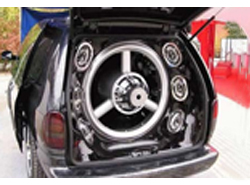Besides vocal mixing – I would say the most common question I read about on the internet is how to manage the low end.
The kick and bass, or whatever else might be occupying that area, is the weight and power of a track. In addition, it’s often the rhythmic backbone.
People tend to have a lot of trouble with low end, and I think there are two specific reasons why:
1) Harder to Hear
A lot of speakers and headphones simply don’t reproduce the low end with great detail and accuracy. You really need large cones, preferably 8-inch or more to be able to produce the low end correctly.
On top of that, rooms need a lot of treatment to manage the low end correctly. Parallel walls and corners tend to distort bass reproduction, making it hard to gauge what you are hearing.
To complicate the issue – the actual bass range is much smaller linearly speaking than higher octaves. You can go from a sub bass A to a bass A in 55 Hz. In the upper ranges, 55 Hz might not even get you to the next note! Ultimately, this mathematically means your bass elements more readily over lap and leave you with less space to make things separate sounding and focused.
2) Frequency Perception
If you set a bass signal at equal amplitude with a mid-range signal, you’ll perceive the bass signal as being quieter (see Fletcher-Munson Curves). This means it takes more juice for the low end to come out booming. Especially if you’re going head first into some heavy compression, which is often the case for dance and hip-hop music. But hey, how important is having a big low end in dance and hip-hop? Oh wait….
So how do we get the low end focused and big?
Delegating Low-End Prominence
Before worrying about focused and big – assign one low end element prominence. Some people will do this by genre. I think that’s dumb (well, semi-dumb). I like to assign my low end captain based on what element is most valuable to the rhythm. By genre, there are certain tendencies:
—Jazz you’re going to be looking to the upright bass
—Dance you are going to be looking at the kick.
—Hip Hop is usually the kick, but it varies.
—Rock, it’s probably a bass guitar, or even a low rhythm guitar.
Regardless – you want the low end to create movement, so you want to lean toward the element that does this in the most exciting way.
Once you’ve figured out your low end leader, the rest is actually not terribly difficult (usually).
Start with volume – get your main player at the right volume. That’s the majority of the work right there. Then, get anything else in the low end to a level that’s present, but not overriding the main element. Think of it as the co-star.



















